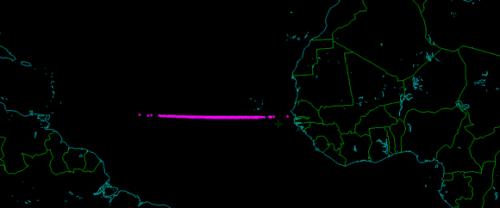It was discovered only one day earlier and according to the calculation was supposed to pass by the Earth. Apparently it burned up entirely in the atmosphere, there were no witnesses to the fall, and the discovery was made by automatic means

By Jason Major, Universe Today
A small asteroid crashed over the Atlantic Ocean on January 2nd. This is shown by radar and satellite tracking. Based on data analysis by Peter Brown of the University of Western Ontario, asteroid 2014 AA struck the atmosphere over the Atlantic Ocean around 03:00 GMT on January 1 at a point over the Atlantic Ocean at longitude 40 degrees West, 12 degrees North about 3,000 kilometers east To the circus in Venezuela. The impact had a force of 500-1,000 tons of TNT, but was very far from a populated area.
Probabilistic pattern of its 2014 AA trajectory south of the Cape Verde Islands. Photo by Asteroid Initiatives, LLC
This was the last orbit around the Sun of asteroid 2014 AA to cross Earth's orbit (and is therefore considered one of the Apollos). This is according to the calculations of several teams of astronomers and published inWorld Astronomical Union Minor Planet Center website.
The asteroid was discovered just one day earlier by the Catalina sky scanner. The object, which was said to be about three meters in diameter, was supposed to pass by the surface of the earth like a knife at a height of 600 kilometers, but now it seems that it has come much closer.
Asteroid Initiatives' diagram shows the estimated entry path of 2014 AA. No eyewitness reports were received.
JPL's Near-Earth Object Program classifies Apollo itself as "Near-Earth asteroids traversing an orbit with a major axis greater than that of Earth (following Asteroid 1862 Apollo). The crash is further proof of the need to observe the Earth's busy path around the Sun.

One response
It's scary that objects can penetrate without us noticing them.
Just imagine a meteor like that of the Tunguska event landing in a populated area.